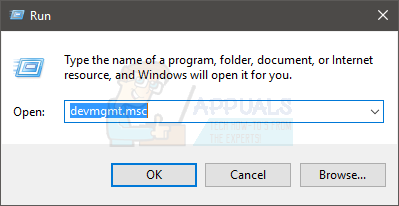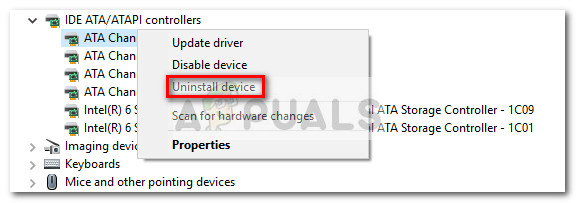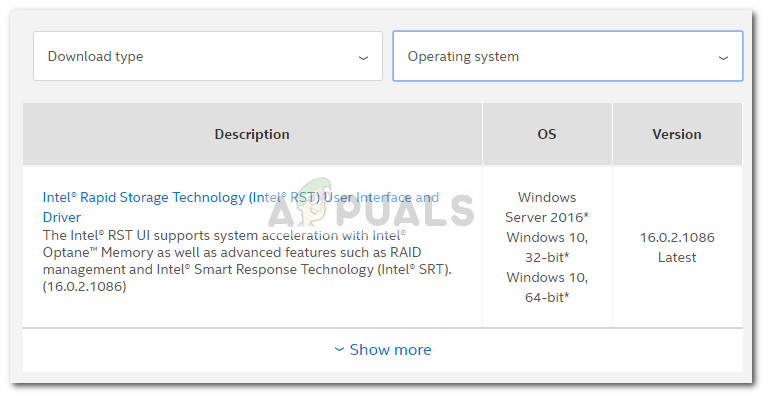Fix: iaStorA.sys Blue Screen
Some users have been reporting BSOD (blue screen of death) crashes that point towards iaStorA.sys as the culprit. Most of the time, the reported error code associated with the BSOD crash is DRIVER_IRQL_NOT_LESS_OR_EQUAL (iaStorA.sys) or SYSTEM_SERVICE_EXCEPTION (iaStorA.sys).

This particular error code signals that a violation occurred in iaStorA.sys, which is part of Intel RST (Rapid Storage Technology). It’s usually an indicator that a kernel-mode driver attempted to access a pageable memory at an IRQL process that was too high. Typically, this bug is caused by drivers that use improper addresses – in our case, the Intel Rapid Storage Technology drier.
If you’re currently struggling with the DRIVER_IRQL_NOT_LESS_OR_EQUAL (iaStorA.sys) or SYSTEM_SERVICE_EXCEPTION (iaStorA.sys), the methods below will most likely help you resolve the problem. Keep in mind that all the personal fixes featured below are confirmed to be working by at least one user. Please follow each method in order until you manage to eliminate the BSOD crash in your particular situation. Let’s begin
Method 1: Removing the IRST drivers
Most users have managed to resolve the issue after finally deciding to uninstall the IRST (Intel Rapid Storage Technology) drivers. The IRST function on Windows has a strong and painful history of being problematic and often times completely unnecessary (on Windows 8 and Windows 10).
If you’re frequently encountering BSOD crashes caused by the iaSTORA.sys and the first method didn’t resolve the problem , follow the steps directly below to remove the IRST drivers from your computer.
One way to do this is to remove IRST from Device manager. Here’s a quick guide to doing this:
- Open a Run box by pressing Windows key + R and type “devmgmt.msc” and hit Enter to open Device Manager.

- In device manager, expand the IDE ATA/ATAPI controllers and systematically uninstall each entry there by right-clicking on each of them and choosing Uninstall.
 Note: Don’t worry about uninstalling all the IDE ATA/ATAPI controllers, you won’t break any functionality. Windows will automatically re-install any removed driver that is needed for the well-functioning of your operating system.
Note: Don’t worry about uninstalling all the IDE ATA/ATAPI controllers, you won’t break any functionality. Windows will automatically re-install any removed driver that is needed for the well-functioning of your operating system. - Once all IDE ATA/ATAPI controllers have been uninstalled, restart your PC and monitors your machine to see if the BSOD returns. If it doesn’t you just managed to resolve the issue.
Note: This is the preferable approach to do this is via the IDE ATA/ATAPI controllers, but some users report that this is not applicable. Some users have reported that the IDE/ATAPI Controllers couldn’t be uninstalled because the IDE Controller didn’t populate Device Manager. If the steps above didn’t work for you, continue with Method 2 to replace the faulty IRST drivers with newer versions.
Method 2: Update the Intel Rapid Storage Technology drivers
If you were unable to uninstall the IRST drivers using Method 1, updating the Intel Rapid Storage Technology driver to a newer version will most likely overwrite the old one.
Some users that were unable to uninstall the IRST drivers from Device manager have managed to resolve the issue by downloading & installing the latest ISRT driver version from the official Intel website. Here’s how to do this:
- Visit this link (here), click on the Intel Rapid Storage Technology (Intel RST) driver, then download the SetupRST.exe installer and agree with the terms in the license agreement.

- Open the SetupRST installer and follow the on-screen prompts to install the newest version of the Intel Rapid Storage Technology.
Note: If you get an incompatibility error while opening SetupRST.exe, download and open this driver (here) instead. - Once the platform drivers have been installed, close the setup and restart your computer. Starting with the next boot, monitor your computer to see if the BSOD crashes caused by the iaStorA.sys have stopped.
If you’re still bothered by the same BSOD crashes (DRIVER_IRQL_NOT_LESS_OR_EQUAL (iaStorA.sys), move to the final method.
Method 3: Doing a Clean install / Windows Reset
If the two methods above didn’t allow you to eliminate the unexpected BSOD crashes, a clean install or a reset is probably the only option by now. If you have Windows 10, the better option would be to do a Windows reset which will allow you to keep your personal files. Follow this article (here) to reset a Windows 10 computer.
If doing a reset is out of the question, you have no other choice but to do a clean install – here’s a quick guide (here) on how to do this on Windows 10.





